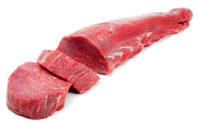Whole-muscle cuts: a sizeable dilemma
The development of larger carcasses adds complexity and complications to merchandising whole-muscle cuts.






Merchandisers of whole-muscle cuts are finding big is not necessarily better.
The production of larger-sized beef, pork and poultry, which has been ongoing over the last few years, shows no signs of abating. It likely will result in the continued development of bigger cuts with inconsistent quality that can impact sales by being too substantial, less tender and costly.
Such factors as herd shortages and lower feed costs are leading producers to develop the large carcasses that generate higher revenues, a trend that will maintain momentum in the foreseeable future, says John Nalivka, president and owner of Sterling Marketing Inc., a Vale, Ore.-based economic analysis forecasting firm for the livestock and meat industries.
“The size and weight of carcasses are getting higher every year,” he says. “At some point we will reach a stumbling block as the cuts get further away from what consumers want.”
He notes most people don’t crave the 16- to 20-ounce steaks derived from large whole-muscle cuts, often preferring portions that are half that size.
“Consumers want smaller cuts and that is not in line with making carcasses bigger,” Nalivka says. “It is a challenge to the industry.”
On the positive side, heavier cattle often benefit processors because they generate added revenues without requiring much more labor.
There is a small cost differential in processing a 900-pound carcass instead of a 600-pound animal, for instance, because each requires the same production steps in plants, says Robert Delmore, a professor in the Department of Animal Sciences at Colorado State University, in Fort Collins.
However, developing larger primals and subprimals make the portioning of cuts particularly challenging.
“Producing more beef with fewer numbers of cattle is great from an environmental and efficiency standpoint,” Delmore says. “But the issue is how big is too big? It is the same situation with pigs and poultry. Animals will not be getting smaller anytime soon and we have not hit the growth peak yet. It means the industry needs to continue to be careful and creative in their merchandising.”
Education is an answer
To sustain shopper interest in larger whole-muscle cuts, marketers need to convince consumers that the items can still result in a positive eating experience if they prepare the proteins properly, says Keith Belk, a professor in the Center for Meat Safety and Quality in the Department of Animal Sciences at Colorado
State University.
“To offer a 17-square-inch ribeye steak in a 10-ounce serving means it will have to be cut very thin, but many people will not know how to properly cook it,” he says.
A reduction in marbling, resulting in less tender cuts, is another quality issue involved with larger carcasses, Belk says.
“The No. 1 value for most producers is having bigger cattle, pigs and poultry because they sell it by the pound and the economics are motivating,” he says. “But that creates problems for merchandisers.”
Large whole-muscle cuts often have prices that “go above that traditional point that consumers are willing to pay,” says Patrick Fleming, director of retail marketing for the Des Moines, Iowa-based National Pork Board.
Pork marketers, as a result, are leveraging a variety of tactics to limit costs and generate and sustain sales.
Retailers and packers, for instance, are breaking ham into smaller pieces by separating individual muscles and cutting the item into quarters, Fleming says.
There also is greater merchandising of St. Louis-style ribs, which tend to be smaller than other ribs in width and length with meat that is typically lean and tender.
“St. Louis-style ribs are easier to prepare and eat and look more like the ribs on restaurant plates,” Fleming says. “It is taking some pressure off the back rib market.”
Other initiatives, he notes, include cutting shoulders and butts in half and separately selling bone-in and boneless versions, which helps to reduce retail prices.
Concerns beyond cost
In addition to attractive pricing, it also is important for whole-muscle cuts to be standard in size and quality to retain shopper interest, says Brett Erickson, director of value-added products for Wooster, Ohio-based Certified Angus Beef LLC.
“Consumers seek consistency in product sizing and prices as much as they seek superior product quality and flavor,” he says. “Fixed sizing allows consumers to regularly find a size and price point that works well for them.”
To offer consistent products at retail, Erickson suggests that processors cut and pre-price items, which enables the proteins to go straight from the box to the meat case.
“For [the] processor, this may mean added costs and labor to weigh and portion items in-house, or a focus on purchasing desired product sizes from suppliers,” he says. “But they deliver long-term benefits for retailers and consumers.”
Golden West Food Group, a Vernon, Calif.-based protein processor and distributor, is responding to higher meat prices by producing smaller portions, says Zack Levenson, chief operating officer. Activities include offering smaller muscle cuts and splitting some cuts in half.
“The main issues have been the pricing hurdle due to higher beef prices and supply shortages due to lower harvest rates,” he says, adding that it beneficial to inform consumers why protein prices are higher than in the past. Such explanations reveal it is an industry-wide problem and not confined to specific merchandisers.
Marketing steaks and chops from larger animals and finding attractive price points for whole-muscle cuts, meanwhile, will remain a sector challenge, says Kent Harrison, vice president of marketing and premium programs for Tyson Fresh Meats Inc., the Dakota Dunes, S.D.-based beef and pork unit of Springdale, Ark.-based processor Tyson Foods Inc.
“We’re able to work around the size of the animal at the plant level, but the size causes problems for retailers,” he says. “The question is, how do you pack it, cut it and price it and still make it attractive to consumers?”
Solutions, he says, include offering value-added products, such as proteins that are marinated and pre-seasoned and ready to cook on the grill.
“It is important to make preparation as easy as possible for the consumer,” Fleming says. “Pre-seasoned meats are a fast-growing segment as it takes a cooking step away from the shopper.”
By any other name
Merchandisers, meanwhile, also can spur greater interest in pork cuts by attaching familiar names to items that are commonly associated with beef products, Harrison says. Bone-in pork chops, for instance, can be marketed as a pork T-bone steak.
“The new names resonate with consumers because it gives them a cue or signal that they can grill the cut on their outdoor deck or patio, just like they would a steak item,” he says. “It benefits to use names that they have seen their entire lives.”
To stimulate greater sales of beef middle meats from larger carcasses, the Centennial, Colo.-based National Cattlemen’s Beef Association (NCBA) created its Beef Alternative Merchandising (BAM) program. The initiative includes training retail meat department personnel on how to cut the top loin, ribeye and sirloin subprimals into smaller, more appealing portions, which typically range between 4 and 8 ounces.
Cuts include top sirloin filet, ribeye filet, strip filet, strip petite roast, ribeye petite roast, top sirloin petite roast and coulotte steak, which is cut from the top sirloin cap.
Retailers also can address price-conscious consumers by merchandising bulk meats at a discount if shoppers cut the meats themselves, says Kari Underly, principal of Range Inc., a Chicago-based meat marketing, training and education firm. Such large portions of beef can include 8 to 10 pounds of top sirloin, 8 pounds of sirloin tips and 15 to 20 pounds of ribeye.
Merchandisers also will benefit by including cutting information on meat packages, such as lines or arrows on clear plastic depicting where the item can be sliced for best results, or attaching stickers to the plastic with cutting and preparation instructions, she says.
“The more work processors can take out of retailers’ hands, the better,” Underly says. “It results in more consistent cutting and reduces the labor at grocery stores.”
Having processors do their part
Certified Angus Beef’s Erickson predicts more processors will become active in merchandising whole-muscle meats, such as by portioning cuts and pre-pricing items for retailers.
“Streamlining the process could create greater efficiencies and reduce costs to satisfy most needs of processors, retailers and consumers, as long as product quality is upheld,” he says.
Educating shoppers on how to best prepare unfamiliar cuts or sizes also will help elevate consumer acceptance.
The key is having cooking instructions on all packages, which Fleming says is rare in most meat departments.
“Our biggest challenge is new consumers coming into the category,” he says. “We assume customers know basic cooking methods, and I’m not sure of that. Providing instructions on-pack will increase the likelihood that shoppers will have a better eating experience, which translates to more repeat purchases.”
While preparation instructions will help drive sales of whole-muscle cuts, it is also important for each retailer to offer the optimal selection of items in the most inviting sizes based on their specific customer bases.
Tyson’s Harrison says that includes merchandising proteins in varying package weights, particularly smaller portions with attractive prices.
“The best product mix will vary for each retailer,” he says. “But there is a need to offer different cuts for different occasions that the shopper can afford on a day-to-day basis.”
The growing size and weight of animal carcasses will continue to have a major impact on the production and merchandising of whole-muscle cuts. But astute processors and retailers that leverage innovative cutting and marketing techniques will be in positon to generate and sustain sales by meeting consumers’ demand for products are that affordable, tasty and simple to prepare.
Looking for a reprint of this article?
From high-res PDFs to custom plaques, order your copy today!










